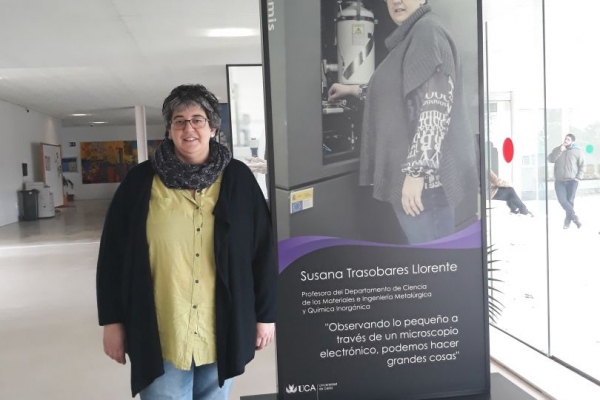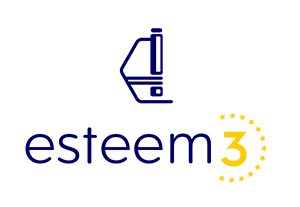ESTEEM3 inteviews : Susana Trasobares Llorente from University of Cádiz

Susana Trasobares Llorente is a professor at the CMIMQI department of the University of Cádiz. She conducts her researches at the "IMEYMAT". In the ESTEEM3 project, she leads the Work Package 8 – Materials for Energy and coordinates the UCA activities in the Work Package 13 – Management of the project.
In this interview, Susana Trasobares Llorente will explain her background, her role, and her views about ESTEEM3.
QUESTION : Tell us something about yourself, your background, and your team.
My research career started at Instituto Carboquímica in Zaragoza (CSIC, 1994). Between 1997 and 2004, the research activity was developed in European and American groups, led by international recognized scientists. In this context, I would like to highlight the work developed within the group led by Sir Prof Harold W. Kroto (Nobel Prize in Chemistry in 1996) and the group managed by Prof. Christian Colliex (world-leader on Electron Energy Loss Spectroscopy) where I did my PhD on "Synthesis and Characterization of New Carbon Nitrogen Structures, Thin Films and Nanotubes”. From January 2002 to September 2004, I was a post-doctoral researcher at several international laboratories : "Rensselaer Polytechnic Institute" and "Argonne National Laboratory". On October 17th 2004, I became a member of the “Structure and Chemistry of Nanomaterials” Group at the University of Cádiz.
QUESTION : Tell us briefly about the last original research you have conducted.
During the last years, I have being applying advanced electron microscopy to characterised a variety of nanomaterials. Among these: the used of probiotic bacteria as carriers of metallic nanoparticles to develop innovative oral agents for hyperthermia cancer therapy, and the key role of atomically thin CeO2 surface layers in the improvement of CeO2/TiO2 reducibility by high-temperature redox treatment.
QUESTION : Present your institute and its tasks within ESTEEM3 ?
The “Structure and Chemistry of Nanomaterials” Group at the University of Cádiz has a more than 20-years-long expertise in the application of Transmission Electron Microscopy techniques to the atomic scale investigation of nanoparticles. Moreover, the team is highly involved in training and dissemination activities, as it has been the design and production of the ESTEEM3 Comic and their participation on the Nano World Workshop at the European Researchers Night.
Within ESTEEM3, the Cadiz team is involved in WP5 (Spectroscopy) and WP8 (Materials for Energy). As an example, the good synergy established between WP5 and WP8 has provided a methodology that allow us to study the oxygen evolution on beam sensitive energy nanomaterials.
QUESTION : Why did you decide to be a part of the ESTEEM3 project ?
Our Research Group had already been involved in ESTEEM and ESTEEM2 projects, where we participated on the development of imaging, the spectroscopy, the advancement of 3D methods and time resolved experiments. In particular the techniques provide within the network were applied to characterize nanomaterials with catalytic applications.
Our participation in ESTEEM3 project allowed us to open our Advanced Electron Microscopy facilities within the framework of the European Project ESTEEM3. We opened our resources and expertise to other researchers, all around world. In this context we have been able to open new collaborations in different fields : astronomy; astrophysics; biomedicine and agriculture.
QUESTION : What are the most challenging aspects of your role and how do you overcome them ?
I must say that the most difficult part has been not having face to face contact, during the pandemic period. It was really challenging to lead the Materials for Energy work package in terms of keeping the contact with all the members. Moreover, I must say that social contact helps for brainstorming and permit us to establish collaboration with other members. Finally, thanks to the effort made by all partners we have been able to overcome all the difficulties and we managed to have collaborations between the partners. As a result, spectroscopy and imaging techniques have been used for quantitative structural and chemical characterization of energy materials.
QUESTION : What is the added value of ESTEEM3 for the European research ?
ESTEEM3 not only offer to the researchers and industry advanced electron microscopy techniques, it also provides expertise who help to apply atomic characterization techniques on a variety of materials. The stablish network also provides education and training to a wide range of academic and researchers community. Last but not least ESTEEM3 is involved in a series of activities dedicated to open science and research to the society in general.
QUESTION : From 12th to 16th September, the University of Cádiz has organised a workshop about “Transmission Electron Microscopy of Nanomaterials”. What were the benefits of the workshop for the participants?
In 2022 TEM-UCA Sumer Workshop, has celebrated its 20th edition. We could say that it has been consolidated as European Reference Workshop for those who want to learn about electron microscopy. During the workshop through a series of lectures and workshops, the students reviewed the advancements of Transmission Electron Microscopy, both imaging and spectroscopic techniques, in the characterization of a wide range of nanomaterials. Moreover, the workshop and of course its location (Cadiz) provides a perfect environment for sharing the knowledge and opening new collaborations which could be further consolidated. Along the years, we have several participants that later on when they have a consolidated position have send their own PhD students to the TEM UCA Workshop.
QUESTION : The ICCON project, carried by Dr. Damien Voiry from the “Institut Européen des Membranes” (IEM) was granted access to facilities of the DME facility of the University of Cádiz. This TA project has already paid off: there are three scientific publications that have been published. How did you live this experience?
This is a collaboration that my colleague Luc Lajaunie had already started a little before ESTEEM3. However, ESTEEM3 allowed us to prioritize our resources on this type of collaboration, especially in terms of microscope time, which allowed us to respond to our international collaborators requests as quickly as possible. In this sense, ESTEEM3 has allowed us to strengthen this collaboration, which has resulted in an important production of good results. And I can tell you even more results are on their way!
QUESTION : What do you expect for the future of the project ?
I wish and hope that the Electron Microscopy community could count on infrastructures as the ones stablished within ESTEEM3 which help to push up not only the techniques developments but also their applications in a variety of fields. I think that we still have a pathway to follow in order to demonstrate the capabilities of advanced electron microscopy in a variety of fields, where the technique is still unknown.
